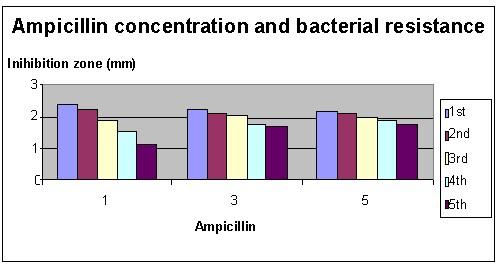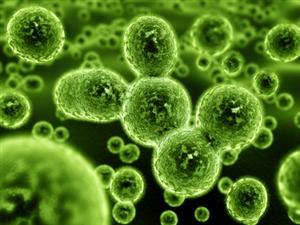| Complexity level: | 8 |
| Project cost ($): | 80 |
| Time required: | 1 day for preparation, 20 days for this science project experiment |
| Material availability: | Access to laboratory equipment (eg. petri dishes) |
| Safety concerns: | Always follow laboratory safety guidelines and always practice sterile technique when handling microbes. Never have any food or drink at your workstation and always thoroughly wash your hands with disinfectant soap or alcohol before leaving your workstation. Always dispose of used material in a biohazard bag. If none are available, the bacteria should be destroyed with bleach before being disposed of. |
Hypothesis
Repeated use of antibiotics causes bacteria to develop resistance which in turn, causes the antibiotic to become less effective in eliminating the bacteria.
Overview
Bacterial resistance
Bacteria and other microorganisms exist all around us. Most of them are harmless to us. Some assist us in digesting our food while others make us sick. The discovery of antibiotics, other antimicrobial agents and immunization have tremendously reduced the proliferation of diseases caused by bacterial infection. However, the excessive use of antibiotics has resulted in bacteria resistance, where the bacteria develops an immunity towards the antibiotic and renders the antibiotic no longer effective.This may lead to the growth and multiplication of a new population of resistant bacteria. This may also lead to a longer recovery time for patients who are suffering from the infection. In addition, stronger and more expensive antibiotics with harmful side effects may have to be used on the patient.
Scientific Terms
Materials
The materials required for this science fair project are:
- 15 agar Petri dishes
- 15 disinfected swabs
- 1 bottle of disinfected water
- 1 piece of filter paper
- 1 hole puncher
- 4 test tubes
- 1 measuring cylinder
- 100mg of antibiotic ampicillin
- 1 digital weighing scale
- 1 beaker of water
- E Coil bacteria culture
- 1 forceps
- 1 marker pen
Procedure
1. The independent variable for this science project is the concentration of the antibiotic used. The dependent variable is the size of inhibition zone (which is the area free frombacteria). This is determined by measuring the diameter of the area using a ruler. The constants (control variables) are the number of times the tests are carried out, room temperature and the ingredients in the Petri dish agar.
2. Prepare 15 Petri dishes using the agar are and store in a refrigerator.
3. Bring 3 of the Petri dishes to room temperature before the start of experiment Label the Petri dishes 1mg, 3mg and 5mg.
4. Prepare and label the antibiotic mixture as follows :
a. Labeled 1mg - 1mg of ampicillin is mixed with 10ml water
b. Labeled 3mg - 3mg of ampicillin is mixed with 10ml water
c. Labeled Marked 5mg - 5mg of ampicillin is mixed with 10ml water
5. Mix 10ml of E Coli bacterium culture with 40ml water in the 4th test tube. Rinse the swab using the disinfected water. Dip it into the test tube containing the bacteria culture and swipe it gently over the agar surface of the 3 Petri dishes. Ensure that you cover the entire surface area of the dish, by rubbing in at least 3 different directions.
6. Punch out circular plates of filter paper using a hole puncher. Label the circular plates of filter paper 1mg, 3mg and 5mg. Pick up the filter paper plates using the forceps and dip them into the ampicillin solution according to the labelled concentrations. Place the filter paper plates at the center of the Petri dish according to their labels and cover them. Keep the dishes in a cool dry place for the bacteria to incubate for 4 days.
7. After 4 days, there will be a circular area around the filter paper plate called the inhibition zone where there will be no bacterial growth. Measure the diameter of this area record it in the table provided below
The concept of the inhibition zone is attributed to the Kirby-Bauer disk diffusion method. This method is used by microbiologists to assess the effectiveness of antimicrobial agents. As the ampicillin diffuses out from the filter paper into the agar, there will be a higher concentration of ampicillin nearer the disk. This concentration decreases gradually, as the distance from the edge of the disc increases. As long as the concentration of ampicillin at any given distance is high enough to properly act as an antibacterial agent, no bacteria will grow at that location. Hence, if the bacteria has increased resistance, a smaller inhibition zone will be seen, and vice versa.
8. Collect the surviving bacteria along the border of the inhibition zone are using the disinfected swab and use it to prepare the bacteria culture needed for subsequent experiments
Repeat steps 3-8 another 4 times. Measure the diameter of the inhibition zone for the repeated science fair projects and record the results in the table provided below.

Results
With each generation, the inhibition zone grows smaller in diameter. Also, the higher the concentration of the antibiotic used, the bigger the diameter of the inhibition zone.
| Ampicillin concentration | The diameter if inhibition zone in Petri dish (mm) | ||||
| 1st generation | 2nd generation | 3rd generation | 4th generation | 5th generation | |
| 1mg | 24 | 22.5 | 19 | 15.5 | 11.5 |
| 3mg | 22.5 | 21 | 20.5 | 18 | 16.5 |
| 5mg | 21.5 | 21 | 20 | 19 | 18 |
Use the below graph to plot the results in the above table.

Conclusion
The hypothesis that the repeated use of antibiotics causes bacteria resistance is proven to be true.
The use if antibiotics should be avoided unless necessary. Overuse of antibiotic causes the bacteria and other microbes to become resistant and causes the antibiotics to become ineffective. Newer and more stronger antibiotics need to be developed to combat the bacteria that have developed the resistance but these antibiotics will be more expensive and with unknown side effects.
Also consider
This science fair project can be repeated by varying the types of bacteria and antibiotics
The experiment can also be repeated by varying the temperature at which the bacteria are left to incubate.
References
Antibiotic resistance - http://en.wikipedia.org/wiki/Antibiotic_resistance
Antimicrobial resistance - http://www.who.int/mediacentre/factsheets/fs194/en/

